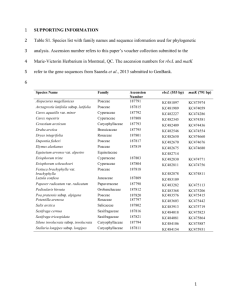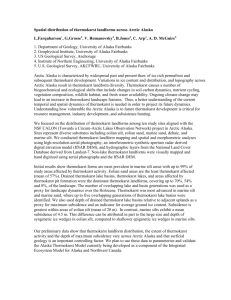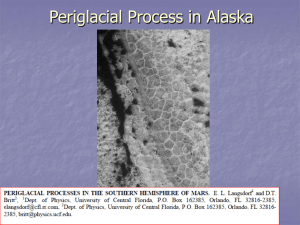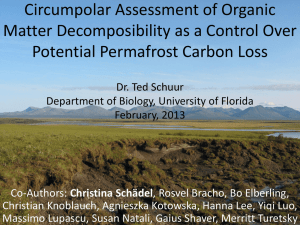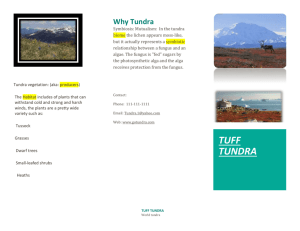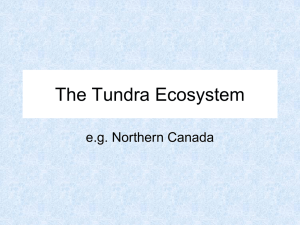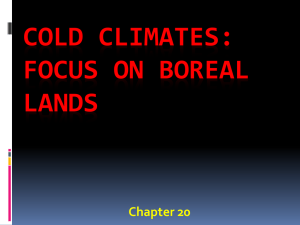Supplement_1 - Scenarios Network for Alaska + Arctic Planning
advertisement
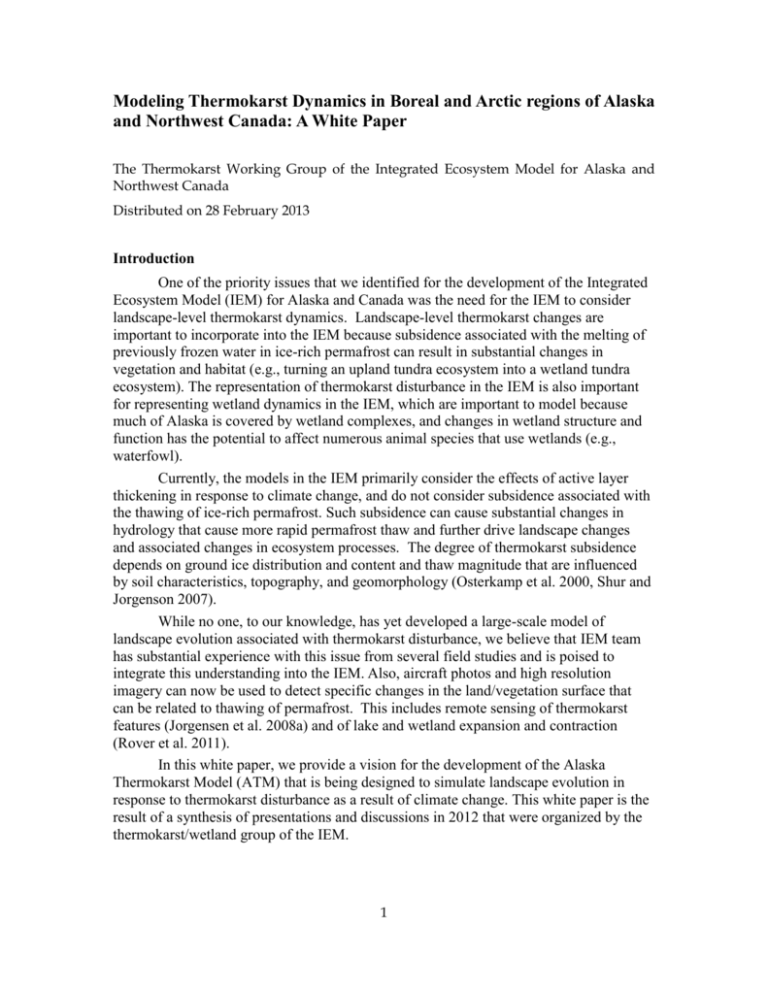
Modeling Thermokarst Dynamics in Boreal and Arctic regions of Alaska and Northwest Canada: A White Paper The Thermokarst Working Group of the Integrated Ecosystem Model for Alaska and Northwest Canada Distributed on 28 February 2013 Introduction One of the priority issues that we identified for the development of the Integrated Ecosystem Model (IEM) for Alaska and Canada was the need for the IEM to consider landscape-level thermokarst dynamics. Landscape-level thermokarst changes are important to incorporate into the IEM because subsidence associated with the melting of previously frozen water in ice-rich permafrost can result in substantial changes in vegetation and habitat (e.g., turning an upland tundra ecosystem into a wetland tundra ecosystem). The representation of thermokarst disturbance in the IEM is also important for representing wetland dynamics in the IEM, which are important to model because much of Alaska is covered by wetland complexes, and changes in wetland structure and function has the potential to affect numerous animal species that use wetlands (e.g., waterfowl). Currently, the models in the IEM primarily consider the effects of active layer thickening in response to climate change, and do not consider subsidence associated with the thawing of ice-rich permafrost. Such subsidence can cause substantial changes in hydrology that cause more rapid permafrost thaw and further drive landscape changes and associated changes in ecosystem processes. The degree of thermokarst subsidence depends on ground ice distribution and content and thaw magnitude that are influenced by soil characteristics, topography, and geomorphology (Osterkamp et al. 2000, Shur and Jorgenson 2007). While no one, to our knowledge, has yet developed a large-scale model of landscape evolution associated with thermokarst disturbance, we believe that IEM team has substantial experience with this issue from several field studies and is poised to integrate this understanding into the IEM. Also, aircraft photos and high resolution imagery can now be used to detect specific changes in the land/vegetation surface that can be related to thawing of permafrost. This includes remote sensing of thermokarst features (Jorgensen et al. 2008a) and of lake and wetland expansion and contraction (Rover et al. 2011). In this white paper, we provide a vision for the development of the Alaska Thermokarst Model (ATM) that is being designed to simulate landscape evolution in response to thermokarst disturbance as a result of climate change. This white paper is the result of a synthesis of presentations and discussions in 2012 that were organized by the thermokarst/wetland group of the IEM. 1 Model Overview The ATM is a state-and-transition model designed to simulate transitions from non-thermokarst landscape units to thermokarst landscape units in boreal and arctic ecosystems in Alaska and Northwest Canada. The model is designed to be integrated into the IEM (see Figure 1), which includes coupled models of fire disturbance (ALFRESCO), soil thermal dynamics (GIPL) and ecosystem structure/function (TEM). Figure 1. The thermokarst model (ATM) is to be integrated into the Integrated Ecosystem Model for Alaska and Northwest Canada by communicating information on thermokarst type, initiation and expansion rate through the Terrestrial Ecosystem Model (TEM). The ATM will use a frame-based methodology similar to that of ALFRESCO to track transitions among non-thermokarst and thermokarst landscape units (cohorts) within 1 km grid cells. A frame-based methodology is a particular way to implement a state-and-transition model by defining frames to determine the fate of each type of landscape unit. A cohort within a 1 km grid cell has a unique state that differs from other cohorts within the grid cell. This state is described by a set of attributes that include the type of landscape unit (e.g., bog or wetland tundra), the time since establishment (e.g., 30 year-old bog), and other features relevant to the fate of the landscape unit (e.g., lowcenter polygon) in the logic of the frame. Although the ATM will not track cohorts in a spatially explicit fashion within 1 km grid cells, it does need to have initial information 2 on the proportion of each cohort within the grid cell. See the section below on “Strategies for Initialization” for a discussion of options for defining the initial distribution of cohorts within each grid cell. The operation of the ATM will be to evaluate the fates of cohorts within the particular 1 km grid cell being considered by the IEM. If there are thermokarst cohorts within a grid cell, then the ATM will cycle through each of the cohorts to determine their individual fates. If there are no thermokarst cohorts within a grid cell, then the ATM will evaluate whether the grid cell is predisposed to experience thermokarst disturbance. Predisposing factors include topography, ground ice content, soil texture, and other conditions that allow the ATM to make a binary decision about whether thermokarst disturbance is a possibility. See the first section of Appendix 1 for an algorithm for determining the predisposition of boreal forest to experience thermokarst disturbance. For example, if only non-thermokarst boreal forest cohorts exist within a grid cell, the predisposing conditions for the possibility of thermokarst might include whether or not (1) the grid cell in a poor (lowland) drainage area, (2) permafrost is present, and (3) there is a sufficient amount of ground ice for thermokarst to cause subsidence. Once the ATM determines that cohorts are potentially subject to thermokarst disturbance, then the ATM calls up a frame logic for the landscape unit type of the cohort. The frame logic will use a logical rule set to calculate the probability that the cohort will remain as its current landscape unit type (parent cohort) and the probability that it will transition to other landscape unit types (new cohorts). Our current thinking is that the probability will be used to determine the areas of these transitions so that the ATM is a deterministic model. The logical rule set will consider factors such as climate, fire, land use, hydrology, erosion, soil texture and ice content. Landscape Unit Transition Sets The definition of the number of frames in the ATM requires the identification of transitions among landscape unit types in a transition set. In the ATM, there will be two sets of landscape unit transitions for thermokarst disturbance in Alaska: (1) those transitions that occur in boreal forest and (2) those transitions that occur in arctic/boreal tundra. Below we describe each of these sets of transitions. Boreal Forest Thermokarst Transition Set The ATM will represent thermokarst-related transitions in the boreal forest that can occur among lowland forest stands, thermokarst lakes, open fens, open bogs, and treed bogs (Figure 2). Thermokarst can occur in forest stands that contain permafrost and soil with moderate to high ice content. As a response to climate warming or fire, permafrost may thaw to a point where the forest floor will collapse as a result of melting ice, which will create a depression where water can potentially accumulate. With changes in local hydrology, lowland forest stands (e.g., black spruce, white spruce, deciduous forest) may then transition to thermokarst lakes, fens or bogs depending on the pre-thaw ice content and the hydrological context. It is also possible for thermokarst lakes to transition to open fens, for open fens to transition to open bogs, for open bogs to transition to treed bogs, and for treed bogs to transition to lowland forest. See Appendix 2 for the description of sample frames for the boreal forest 3 thermokarst transition set. See Appendix 3 for some initial progress that we have made in specifying the rules for the probability of thermokarst disturbance in the boreal forest thermokarst transition set. Figure 2. As permafrost thaws, lowland boreal forest stands may transition to thermokarst lakes (TK lake), fens or bogs depending on pre-thaw ice content and the hydrological context. Arctic/Boreal Tundra Transition Set In arctic/boreal tundra, the ATM will consider thermokarst-related transitions among wetland tundra, graminoid tundra, shrub tundra, shallow thermokarst lakes, and deep thermokarst lakes (Figure 3). The transitions among these landscape unit types are tightly coupled with physical changes in soil temperature and moisture. Cold and wet soils favor wetland tundra, cold and dry soils favor graminoid tundra, and warm and dry soils favor shrub tundra. Wetland tundra is dominated by wetland sedges, grasses and mosses, and is typically found on the coastal plain of Alaska. Graminoid tundra, which is often synonymous with tussock tundra, is generally dominated by sedges and grasses, but also contains forbs, mosses, lichens, and low-stature shrubs. Shrub tundra is generally dominated by short- to tall-stature shrubs. Shallow thermokarst lakes and deep thermokarst lakes occur in areas of poor drainage where water cannot drain off the landscape. 4 Figure 3. Potential transitions among vegetation/landscape states due to changes in temperature, soil moisture conditions, and thermokarst disturbance. S, M, and R indicate slow, moderate, and rapid transitions, respectively. Notation of the various components, L, H and ?, indicate low, high, and unknown resiliency, respectively. An important feature of the arctic/boreal tundra thermokarst transition set is that the frames for wetland, graminoid, and shrub tundra will contain rules that represent the dynamics of ice wedges in response to climate change or fire to drive landscape evolution as thermal and moisture conditions change. Ice wedges are most obvious in wetland tundra where, for example, low-centered polygons in wetland tundra are present where the ice-wedges are actively forming and growing. Ice-wedge dynamics result in the formation of micro-patterns of different vegetation and soil types, like wet low-center polygon centers versus drier polygon rims that may support shrub growth. In the intrapolygonal ponds, high soil moisture conditions will result in shallow standing water. Degradation of ice-rich permafrost and the melting of wedge ice will lead to surface collapse and transformation of low center polygons to high center polygons (Meyer, 2003). High-centered polygons form as the polygon rims and troughs, which are underlain by massive ice wedges and tend to degrade faster than the polygon center. This results in subsidence and water accumulation in polygonal trough ponds that visually give the effect of an elevated center of the polygon. High center polygons of wetland tundra can transition to shrub tundra or to graminoid tundra. Alternatively, extensive thermokarst of ice-rich permafrost soils can result in the formation of large ponds or lakes 5 that form from coalescing smaller ponds and lateral expansion by shore thermal erosion. If a lake drains, permafrost can be restored within the drained lake basin under sufficiently cold climate conditions to cause transitions to wetland tundra. If climate conditions are not cold enough, the drained lake basin will not refreeze. See Appendix 4 for the description of sample frames for the arctic/boreal tundra thermokarst transition set. See Appendix 5 for some initial progress that we have made in specifying the rules for the probability of thermokarst disturbance in the arctic/boreal tundra thermokarst transition set. Issues in Coupling the ATM into the IEM The ATM is designed to be a model that is implemented annually. In Figure 1 we have depicted the ATM as primarily relying on inputs from and providing output to TEM. The exchange of data between the models hasn’t been finalized, but our current thoughts are that the ATM will require inputs on the landscape unit types of the cohorts within a grid cell, the presence/absence of permafrost, soil temperature, soil moisture, thaw depth, and organic layer thickness. After the implementation of the ATM for one annual time step, it would provide TEM with information on the landscape unit types of each cohort, the relative area of each cohort, and the other attributes of each cohort (e.g., age since subsidence). Because the ATM has the ability to create new cohorts from parent cohorts through landscape unit transitions, TEM would then decide on the fate of carbon and nitrogen pools based on the transitions being implemented in new cohorts. This is very similar to how TEM currently handles fire disturbance. Thus, one of the major changes to the IEM will be to track landscape unit types as cohorts within 1 km grid cells. The ALFRESCO modeling group will need to think about how this affects the operation of ALFRESCO, as ALFRESCO currently assumes one landscape unit type per grid cell. Also, there may be issues that emerge in reconciling thermokarst-related transitions considered by the ATM with fire- and successionalrelated transitions currently considered by ALFRESCO. It may be that TEM will be the nexus for reconciling these transitions. At this point in time, our intention is to point out the possible need to resolve these issues. As a group the IEM team should wait until we have a mature working version of the ATM before attempting to address the details of resolving such issues. However, if there are thoughts that affect the development of the ATM, it would be good to be aware of these in the near future. Strategies for Initialization of Landscape Units and their Attributes The current initial vegetation of the IEM describes vegetation types as completely occupying 1 km grid cells (Figure 4). Because the ATM needs to represent landscape units (cohorts) within 1km grid cells, there will be the need to represent the proportion of each of the landscape unit types considered by the ATM along with their attributes (e.g., age since thermokarst disturbance, polygon type, etc.) for each 1 km grid cell. One way to proceed may be to gather as much information on possible cohorts within grid cells by mining that information from finer resolution land covers. For example, the National Land Cover Database (NLCD) Alaska is a 30-m resolution data set (Figure 5) that may 6 be useful in defining the proportion of 1-km grid cells covered by various landscape unit types considered by the ATM. For example, open water in the NLCD Alaska might be able to be related to shallow thermokarst lakes, deep thermokarst lakes, and nonthermokarst lakes; herbaceous wetlands to fens and bogs; and woody wetlands to treed bogs. There are several tundra vegetation types in the NLCD Alaska that could be used to define the proportion of wetland, graminoid, and shrub tundra within 1 km grid cells. Datasets such as NLCD Alaska will not provide all of the information necessary to define cohorts. For example, some of the issues that need to be resolved include (1) how to divide boreal wetlands among open fens and open bogs, (2) how to assign attributes for polygon type (low center, transitional, and high center) to different tundra cohorts, and (3) how to assign the age since thermokarst disturbance attribute to cohorts. Also, the USGS National Hydrography Dataset (NHD) for Alaska may be useful for distinguishing between shallow, deep, and non-thermokarst lakes throughout Alaska. See Appendix 6 for the results of some research we have conducted on a possible strategy to divide boreal wetlands into open fens and open bogs based on their distribution in the Tanana Flats. Figure 4. The initial land cover input data for the Integrated Ecosystem Model for Alaska and Northwest Canada. Vegetation types are described at 1 km resolution. 7 Figure 5. The National Land Cover Database (NLCD) Alaska is based on Landsat land cover classification and has 30 m resolution. Other Spatial Data Sets Required for the Operation of the ATM Besides the development of the data set that defines the initial cohorts for the application of the ATM, there are several other data sets that will be required for the operation of the ATM and may require development. Below is a list of data sets that we have currently identified as being required by the ATM: (1) Ground ice maps. One option for developing these maps is from Jorgenson et al (2008b) NICOP Alaska Permafrost map (distribution and generalized ice content based on current presence of shallow or deep thermokarst forms). (2) Surface geology and soil texture. Again, one option is to develop these data sets from Jorgenson et al. (2008b) NICOP Alaska Permafrost map. (3) Alaska digital elevation model at 60m resolution; and/or 300m Alaska DEM; elevation derivatives (slope). Besides these data sets, we also anticipate that our research over the next year may define other spatial data sets that may be required for the operation of the frames. For example, in the arctic/boreal tundra transition set, these may include spatial data sets 8 of a distributed drainage efficiency parameter, a distributed ice content/form parameter, a distributed rate of subsidence, and a distributed protective layer parameter (See Appendix 5). We currently don’t know the specific of what would be required for such spatial data sets. Our purpose here is to let the IEM data group know that we will be defining the need for additional spatial data set development as we make progress in model development. Strategy for Model Development, Testing, and Application The 2013 objectives of the thermokarst group of the IEM team are to develop the code for the ATM and to test the code for its operation at landscape scales. The 2014 objectives are to incorporate the ATM into the IEM and to conduct a proof of concept study. The 2015 objectives are to apply the version of the IEM with the ATM across the IEM domain. The 2016 objectives are to develop and apply an impact model that would make substantial use of the ATM-related outputs of the IEM. In 2013 we will have one postdoctoral scientist working on development of the code for the boreal forest thermokarst transition set and another postdoctoral scientist working on the code for the arctic/boreal tundra thermokarst transition set. The thermokarst/wetland group will work with the postdoctoral scientists during 2013 to refine the logic of each of the frames in the two thermokarst transition sets. Much of this interaction will happen at the monthly meetings of the thermokarst/wetland group. The Tanana Flats will be the test region for evaluating the dynamics of the boreal forest thermokarst transition set so that we can take advantage of studies on thermokarst dynamics in that region (e.g., Jorgensen et al. 1999). Coastal tundra near Barrow will be the test region for evaluating the dynamics of the tundra thermokarst transition set so that we can take advantage of studies on thermokarst dynamics in that region (e.g., ongoing studies that are part of the NGEE-Arctic DOE effort). Much of the evaluation of the dynamics of the ATM will be to compare the simulated expansion rates of thermokarst landscape units to what has been observed (Jorgenson et al. 2001, Jorgenson et al. 2005, Jorgenson et al. 2008a, Grosse et al. in preparation). After evaluating the operation of the ATM in these two regions, near the end of 2013 we anticipate applying the ATM as a stand-alone model in the two regions for climate scenarios to go extend to 2100. This will be an activity that not only demonstrates the capabilities of the ATM, but will be useful for defining the spatial data sets that will be required to operate the ATM across the IEM domain. This exercise will provide important information for the model coupling and the data groups of the IEM to support the incorporation of the ATM into the IEM during 2014, the proof-of-concept application of the coupled model in 2014, and the application of the coupled model across the IEM domain in 2015. 9 Appendix 1. An Analysis of the Predisposition of Boreal Forest Grid Cells for Thermokarst Disturbance. In the boreal forest, predisposing factors may include topography, ground ice content, soil texture, and other conditions that allow the ATM to make a binary decision about whether thermokarst disturbance is a possibility. The key topographical issue is to separate lowlands from uplands. We developed the criteria to differentiate lowlands and uplands based on a spatial analysis of the distribution map of fens and bogs for the Tanana Flats in Interior Alaska (Jorgenson et al. 1999). The analysis was conducted at 1km resolution, the resolution of operation of the ATM. The topographic parameters used in the analysis were computed from the USGS Digital Elevation Model (DEM) (Earth Resources Observation and Science Center, http://eros.usgs.gov). Various parameters were tested: slope, log-transformed flow accumulation (FA), the compound topographic index (CTI), and the standard deviation of the log-transformed elevation (ESD; estimated from the eight direct neighbors of each 1*1km pixel). FA is derived from a cumulative count of the number of pixels that naturally drain into outlets. This calculation uses the flow direction, and the largest outlets have the largest values. The CTI is a function of slope and FA (Moore et al. 1993). A classification tree analysis was conducted to define the topographic conditions in which lowlands and uplands occur. In the Tanana Flats, the lowlands were distributed in (1) flat areas where log(ESD) was < 1.189 and (2) wet areas where CTI > 467. This model was able to predict 96.7% of the lowlands in the Tanana Flats. The GIPL model will simulate whether or not permafrost is present in the landscape unit. A ground ice map possibly based on the map of ground ice content associated with superficial deposits for Alaska (Jorgenson et al. 2008b) will be used to assess ice content. Thermokarst is most likely to occur in silty soils and least likely to occur in sandy soils. Thus, a soil texture map will be used to determine if a grid cell is predisposed to experience thermokarst. The logic for integrating the various factors might go something like this: 1. Calculate CTI and ESD to determine whether the grid cell is located in lowland or upland. If CIT>467 and ESD<1.179, then the grid cell is located in lowland and go to step 2, otherwise, move onto the next grid cell. 2. Check the soil ice content to determine if there is enough ground ice content for thermokarst disturbance. We will use the criteria of ice content less than 10% volume (Jorgenson et al. 2008b) as an indication that conditions are not conducive to thermokarst. In this case, we move onto the next grid cell. Otherwise, we move onto step 3. 3. If GIPL indicates that permafrost is present and that the mineral soil is not sandy, then we cycle through the cohorts of the grid cell, calling up the appropriate frame logic for each cohort. 10 Appendix 2. A Sample Frame for the Boreal Forest Thermokarst Transition Set. The frame diagram for forest stands in the boreal forest is depicted in Figure A21, in which there are transitions from forest stands (black spruce, white spruce, or deciduous forest) to thermokarst lakes, bogs, and fens. Upwelling Moderately ice rich Warming, Fire Plateau Forest Stands Warming, Fire Highly ice rich Fen Bog TK lake Warming, Fire Figure A21. The frame diagram for thermokarst-related transitions from forest stands in the boreal forest to thermokarst lakes, bogs, and fens. The rules for the initiation of fens, bogs, and thermokarst lakes are outlined below and diagramed in Figure A22 and A23. 1. Are there fens, bogs, or thermokarst cohorts in the grid cell? ” If yes, then go to the rules for expansion of existing fens, bogs, and thermokarst lakes. Otherwise go to the rules for initiation of fens, bogs, and thermokarst lakes. 2. For the new initiation logic, if the probability of thermokarst is greater than the threshold probability A (see Appendix 3), then a new thermokarst is initiated and go to step 3. 3. If the soil ice content >40% volume, then create a thermokarst lake. Otherwise, go to step 4. 4. The logic for deciding if the thermokarst initiated in a forest stand will transition to a fen or a bog depicted in the decision tree of Figure A22. Figure A22. The decision tree for deciding the transition of thermokarst that initiates in a forest stand to a fen, bog, or a co-occurring fen/bog (see Appendix 6 for more details). 11 Expansion or transition of fen, bog or TK lake Yes Boreal forest Start Any bog, fen or TK lake area? No A new initiation of thermokarst No Initiation probability P >A? Yes Ice content>40 %? Yes TK lake No Yes Fen Log(ESD) No Log(FA) >=1.667? >=0.139? Bog Yes No Yes Fen/Bog Log(ESD) >=0.284? Log(FA) >=3.583? No No No Yes Log(ESD) Fen >=0.139? Yes Fen Figure A23. A depiction of the frame logic for thermokarst-related transitions from forest stands in the boreal forest to thermokarst lakes, bogs, and fens. 12 Appendix 3. A Possible Strategy for Estimating the Probability of Thermokarst in Boreal Forest Landscape Units. The probability distribution for estimating the probability of thermokarst in boreal forest landscape units was estimated from active layer thickness measurements (Figure A31) between 1994 and 1998 at 240 sites distributed in various vegetation communities of the Tanana Flats (Jorgenson et al. 1999). Figure A31. Mean annual active layer thickness for the different vegetation communities inventoried in the Tanana Flats. Thermokarst fens are the red bars; thermokarst bogs are the green bars. The horizontal lines represent standard deviation. Based on the data in Figure A31, Michaelis-Menten and Logistic models can be developed to estimate the probability function (P) of thermokarst (fen or bog) initiation (Figure A32). 13 Figure A32. Candidate probability of subsidence function (Michaelis Menten left and Logistic right) developed from the data in Figure A31. 14 Appendix 4. Some Frames for the Arctic/Boreal Tundra Thermokarst Transition Set. Below, we provide descriptions of the frames for each of the tundra vegetation types considered by the tundra thermokarst transition set: wetland tundra (Figure A41), graminoid tundra (Figure A42), and shrub tundra (Figure A43). In each of the frame figures, the parent tundra type is displayed in the top center. Wetland Tundra By the physical nature of wetland tundra environments, we assume that only moderate- and high-ice contents of the soils can exist (low ice content is not possible). If the drainage efficiency threshold is not exceeded, thermokarst will result in either shallow or deep ponds/lakes, depending upon the ice-content. If the drainage efficiency threshold is exceeded, the landscape is assumed to be dominated by ice-wedge polygons. Under the right conditions, low-center polygons will degrade to high-center polygons. The thermal and moisture conditions that result in high-center polygon centers will be favorable to graminoid tundra and the surrounding polygon trough edges and troughs may be favorable to shrub tundra. Troughs may also become water filled in flat terrain and ultimately connect and expand to larger ponds/lakes. As mentioned above, changes in vegetation composition will only occur under favorable climatic conditions. Figure A41. The wetland tundra frame for transitions involving thermokarst disturbance. 15 Graminoid Tundra Simulating the thermokarst process and its associated vegetation trajectories that begin in the graminoid tundra environment will be complicated. Thermokarst in graminoid tundra can lead to each of the major landscape unit types (graminoid tundra, shrub tundra, wetland tundra, ponds/lakes), dependent upon the moisture conditions (drainage efficiency) and ice-content. There are three different potential pathways for graminoid tundra. 1. The first pathway is the direct and rapid change due to wildfire. In this scenario, changes in vegetation composition will be handled by the ALFRESCO based on the research of the Tundra Fire and Treeline Dynamics Working group of the IEM team. 2. The second pathway occurs if the drainage efficiency threshold is exceeded. In this scenario, it is again assumed that ice-wedge polygons dominate landscape. If the active layer depth exceeds the protective layer over time, low-centered polygons will eventually degrade to high-center polygons. As opposed to the wetland high-centered polygons, we believe that the thermal and moisture conditions will be more conducive for shrubs in both the high-center polygon centers as well as the troughs. 3. The third and final pathway occurs if the drainage efficiency is not exceeded. In this scenario, the resulting thermokarst form is dependent upon the underlying ice-content and form. If a low- to moderate-ice content exists, the landscape will gradually subside, eventually leading back to a wetland tundra environment. In the case of high- to massive ice-content, shallow thermokarst ponds/lakes will appear. Shallow ponds/lakes may continue to degrade into deep ponds/lakes or they may drain. If they drain, they will eventually return to wetland tundra vegetation type. 16 Figure A42. The graminoid tundra frame for transitions involving thermokarst disturbance. Shrub Tundra Thermokarst in areas with shrub tundra can eventually lead to graminoid tundra or shrub tundra with high center polygons. This is due to the assumption that shrub tundra is largely present in well-drained (dry) and relatively warm soils. As shown in Figure A43 below, there are two main pathways in which shrub tundra can shift to another vegetation type. The first is due the rapid process of wildfire. Based on the work of the Tundra Fire and Tree Dynamics working group of the IEM team, ALFRESCO will simulate that process and resulting vegetation composition. The second pathway occurs in moderate- to high- ice-content soils and in areas that do not exceed the drainage efficiency threshold. If all the thresholds are met, thermokarst in this region is again assumed to occur in areas where ice-wedge polygons dominate. Thermokarst in this region will result in degradation of the ice-wedges that outline the polygon features, eventually leading to high-centered polygons. If these high-centered polygons continue to degrade, shallow ponds/lakes would result. 17 Figure A43. The shrub tundra frame for transitions involving thermokarst disturbance. Thermokarst Lake Dynamics Thermokarst ponds and lakes in the model will be tracked as cohorts. In Alaska, typical lake area coverage (limnicity) for permafrost regions range from 0 to about 40%. In addition to existing thermokarst lakes (based on the NHD lake dataset), the above thermokarst frames will project where new ponds/lakes are forming. Starting with a shallow thermokarst pond that expands in area, the trajectory may include 1) drainage, 2) drying, 3) terrestrialization, 4), stabilization, or 5) growth to a deep lake. Growing into a deep lake may then later result in 1) drainage, or 2) stabilization. Terrestrialization (slow/gradual process) or lake drainage (instant process) results in a thermokarst basin with fen vegetation in the boreal forest and arctic tundra region, and then slowly transitions to bog in boreal region and wetland tundra in the arctic. Similar to the active layer and the protective layer, several layers need to be considered for thermokarst lake dynamics. Once initiated, a lake bottom mean annual temperature of >0degC results in further thaw and subsidence given that the active layer (or more precisely, the unfrozen zone under a lake) exceeds the protective layer thickness and that the layer with excess ice content is still not fully exhausted. A lake depth layer (“lake thickness”) will track water depth, which is relevant for the mean annual bottom temperature. 1) Drainage: In thick continuous permafrost lakes drain when reaching a lateral 18 2) 3) 4) 5) drainage gradient by their gradual shore expansion via thermo-erosion; in the discontinuous permafrost zone, lakes may drain internally when their talik breaches the bottom of the permafrost layer. Drying: depending on P-E, shallow lakes may dry in highly continental regions of Interior Alaska or the semiarid regions of the Northslope. Terrestrialization: Shallow lakes may be encroached by highly productive shore fen vegetation; this process seems currently limited to the boreal forest region and the western Alaska tundra regions (Seward Peninsula, Yukon-Kuskokwim Delta) Stabilization: Shallow lakes that either fully penetrate the ice-rich layer or substantially increase the protective layer may become stabilized landscape features and only slowly expand laterally Growth to a deep lake: If the ice-rich layer is sufficiently ice-rich and deep and other environmental conditions do not prevent growth, a thermokarst lake may deepen to >10 m depth; 19 Appendix 5. A Possible Strategy for Estimating the Probability of Thermokarst in the Arctic/Boreal Tundra. Thermokarst can occur in areas where the active layer increases beyond average maximum depths and taps into ice-rich soils. The thawing of permafrost can result in thermokarst pits, the transition from low-center to high-center polygons, and shallow or deep ponds/lakes formation. The trajectory and form of topographic changes, and resulting vegetation depends on the 1) the “drainage efficiency” (Figure A51); 2) the distance between the soil surface and ice-rich soils (the “protective layer” thickness) (Fig A52); and 3) the amount and form of ice in the permafrost soils. The parameterization of these processes – specifically, the drainage efficiency and the rate of subsidence and subsequent changes in the protective layer thickness – is the most difficult task in the model development process for arctic/boreal tundra environments. The “drainage efficiency” parameter describes the ability of the landscape (or grid cell) to store water. The drainage efficiency is a function of topography, climate, active layer depth, soil texture, and the degree to which the landscape is hydrologically connected (Figure A51). The drainage efficiency accounts for vertical (climate, soil storage) and lateral (surface and subsurface runoff governed by topography and soil properties and hydrologic connectivity) processes of water movement over time. The drainage efficiency (and whether or not the threshold has been crossed) is important as it sets the direction of both thermokarst form and pathway changes in vegetation composition due to a changing landscape. The mathematical derivation of this parameter still needs to be developed. Figure A51. The dependence of the drainage efficiency parameter on topography, climate, soil storage, and lateral flow. 20 The “protective layer” is defined to be the distance between the land surface and ice-rich soils or the top of massive ice bodies (such as an ice wedge or buried glacial ice) (Figure A52). Figure A52. The relationship among the active layer, the protective layer (the lines with the arrows above the ice wedge), and the top of massive ice bodies in the soil. Physically, the protective layer serves as a buffer between the processes that occur at the land surface and the underlying soils that are susceptible to thermokarst, specifically ice-rich soils. If the seasonal thaw of the soil does not penetrate the protective layer completely, the thermokarst process will not take place. However, if the seasonal thaw of soil does penetrate the protective layer and melts ice, the soil structure/column will be altered. As ground-ice melts and the melt water flows away, the land surface will gradually subside. In case of melting pure ice (e.g. ice wedge) the surface subsidence may be as large as the thickness of melted ice layer and the protective layer thickness will not increase immediately. However, if the subsidence is triggered by thawing of a icerich soil, the subsidence will be less than the thickness of the thawed ice-rich layer by the amount of mineral or organic soil content in this thawed layer resulting in an increased protective layer thickness. Moreover, in both cases the deposition of mineral and/or organic material in the developing depressions may farther increase the thickness of the protective layer. However, the subsidence may result in hydrological rerouting or collection of precipitation and lead to ponding which strongly enhances heat transfer into the ground and deepens thaw penetration. Bottom temperatures of shallow water bodies have been shown to be several degrees (sometimes exceeding 10 oC) above that of surrounding tundra. The heat transfer from a water body into underlying permafrost increases with water volume and substantially accelerates when reaching a water depth exceeding the threshold of bottom fast ice, when the water body will have liquid water year-round and 21 exercise its thaw impact on underlying permafrost year-round. A lake talik will develop at speeds depending on water, sediment, and permafrost temperatures (Ling et al., 2004; Plug & West, 2009; West & Plug 2008). The degree (or amount) of increased protective layer also depends on sediment transfer processes (high energy, hydrologically well-connected environments will have a relatively small amount of protective layer increase compared to low energy, hydrologically disconnected environment (a pond or lake)). The increasing thickness of the protective layer serves as a negative feedback, and potentially a stabilizing factor, to the thermokarst process; however, the increase in water depth often more than offsets the growth of the protective water. As the protective layer increases, additional 'heat' energy is required to penetrate the protective layer. The balance between the annual heat energy supplied and the thermal properties (e.g. thickness and material) is a significant factor in determining of the expansion [horizontal and vertical] rate of thermokarst. For each tundra landscape unit, we ask the following questions to determine whether thermokarst will or will not be initiated: 1) Has the drainage efficiency threshold been crossed? As described above, this question relates to the moisture conditions and hydrologic connectivity (the ability of water to move horizontally across the landscape). If the drainage efficiency threshold has been exceed, the landscape is relatively dry compared to a region that is below the drainage efficiency threshold. 2) Is the active layer depth greater than the protective layer? If the active layer depth (or seasonal thaw layer??) is greater than the protective layer, thermokarst can occur. The degree (amount) of landscape change is based upon a number of other factors, especially ice-content and form. There are two different ways that this question can be answered. The first is if the amount of heat input to the system changes, i.e., if the heat input to the system increases, the resulting active layer depth (seasonal thaw layer) will most likely increase and vice versa. Heat input can be changed via a number of mechanisms that include mean annual air temperature changes, fire events, water ponding, changes in snow cover thickness, timing, and duration, and changes in vegetation cover and soil organic layer thickness. The second way is due to changes in the protective layer. As the landsurface subsides, there will be changes to the protective layer thickness (described above). If the protective layer increases to a non-penetrable depth (by the active layer depth/seasonal thaw layer), thermokarst will not take place [at that time step]. However, changes in topography may result in a reduced protective layer. If the landscape becomes more 'steep', the ability of surface water to transport protective layer sediment across the landscape may increase due to increasing energy; In addition, fire may reduce the thickness of the protective layer by burning of portions of the soil organic layer. 3) What is the ice-content of the soils? The answer to this question determines the resulting physical landscape change due to thermokarst. If the ice-content of the soil is high (including massive ice), changes in the landscape due to thermokarst has a much greater potential depending upon the other factors described above (e.g. penetration depth of the protective layer). If the landscape is ice-poor, the resulting thermokarst will be minimal or absent, despite how well the other 22 factors favor thermokarst. Ice content relevant for thermokarst will need to be defined as excess ice content (ice content that exceeds the pore volume of the soil/sediment) that can translate into volume loss and subsidence upon permafrost thaw (e.g., Pullman et al., 2006). 23 Appendix 6. A Possible Strategy for Defining Fens and Bogs in Boreal Wetland Complexes of Alaska and Northwest Canada. Fens can be differentiated from bogs in terms of their water supply. Fens are defined as wetlands where the vegetation gets its water supply mainly from ground water flow. The source of water is generally located outside of the fen. Fens can range from moderately acidic to mineral rich, and are generally dominated by grasses and sedges. In comparison, bogs are defined as wetlands where the vegetation gets its water supply primarily from precipitation (poor to no connection between the surface vegetation and the groundwater flow). These ecosystems are acidic and are generally dominated by moss species. If the environmental conditions allow moss growth and the disturbance history allows substantial peat accumulation, a mesotrophic fen can transition to a bog ecosystem. To spatially distinguish fens and bogs, we conducted an analysis of the distribution of fens and bogs from the vegetation map for the Tanana Flats (Jorgenson et al. 1999; see Figure A61). Figure A61. Distribution of thermokarst bogs and fens in the Tanana Flats, Interior Alaska. Two factors that were useful in distinguishing fens and bogs are flow accumulation (FA) and the standard deviation of elevation of the surrounding grid cells (ESD). The classification tree differentiates bogs, fens and co-occurring bogs and fens is presented in Figure A62. This model predicts 61 % of the cells containing bogs only, 24 89% of the cells containing fens only and 32% of cells containing bogs and fens. Figure 6: Decision tree in which flow accumulation (FA) and standard deviation of elevation (ESD) are used to spatially distinguish between the location of bogs and fens. 25 References Jorgenson M.T., Roth J.E., Raynolds M.K., Smith M.D., Lentz W., Zusi-Cobb A.L., Racine C.H. 1999. An ecological land survey for Fort Wainwright, Alaska. CRREL report 99-9. 83 pp. Jorgenson M.T., Racine C.H., Walters J.C., Osterkamp T.E. 2001. Permafrost degradation and ecological changes associated with a warming climate in central Alaska. Climatic Change 48: 551-579. Jorgenson M.T., Osterkamp T.E. 2005. Response of boreal ecosystems to varying modes of permafrost degradation. Canadian Journal of Forest Research 35: 2100 2111. Jorgenson M.T., Shur Y., Osterkamp T.E. 2008a. Thermokarst in Alaska. Proceedings of the Ninth International Conference on Permafrost. 8pp. Jorgenson, T., Yoshikawa, K., Kanevskiy, M., Shur, Y., Romanovsky, V., Marchenko, S., Grosse, G., Brown, J., and Jones, B. 2008b. Permafrost Characteristics of Alaska. Ninth International Conference on Permafrost, University of Alaska Fairbanks, June 29 - July 3, 2008. Extended Abstracts, 121-122. Ling F., Zhang TJ. 2004 Modeling study of talik freeze-up and permafrost response under drained thaw lakes on the alaskan arctic coastal plain. Journal of Geophysical Research-Atmospheres 109. Meyer, H.: Studies on recent cryogensis, In: Grigoriev, M.N., Rachold, V., Bolshiyanov, D.Y., Pfeiffer, E.M,. Schirrmeister, L., Wagner, D., and Hubberton, H.W. (eds), Russian-German Cooperation System Laptev Sea. Vol 466. The expedition LENA 2002. Ber Polarforsch Meeresforsch, pp 29-48. Moore I.D., Gessler P.E., Nielsen G.A., Petersen G.A. 1993. Terrain attributes: estimation methods and scale effects. In: Modeling Change in Environmental Systems, Eds. Jakeman A.J., Beck M.B., McAleer M. pp. 189 - 214. Osterkamp, T.E., L. Viereck, Y. Shur, M.T. Jorgenson, C. Racine, A. Doyle, and R.D. Boone, 2000. Observations of thermokarst and its impact on boreal forests in Alaska, U.S.A. Arctic, Antarctic, and Alpine Research, 32, 303-315. Plug L.J., West J.J. 2009 Thaw lake expansion in a two-dimensional coupled model of heat transfer, thaw subsidence, and mass movement. Journal of Geophysical Research-Earth Surface 114. Pullman E.R., Jorgenson M.T., Shur Y. 2007 Thaw settlement in soils of the arctic coastal plain, Alaska. Arctic Antarctic and Alpine Research 39:468-476 Rover, J., L. Ji, B.K. Wylie, and L.L Tieszen. 2012. Establishing water body areal extent trends in interior Alaska from multi-temporal Landsat data. Remote Sensing Letters 3:595-604. Shur, Y.L. and M. T. Jorgenson, 2007. Patterns of permafrost formation and degradation in relation to climate and ecosystems. Permafrost and Periglac. Process, 18: 7–19 West, J. J., and L. J. Plug. 2008. Time-dependent morphology of thaw lakes and taliks in deep and shallow ground ice, J. Geophys. Res., 113, F01009,doi:10.1029/2006JF000696. 26 27
